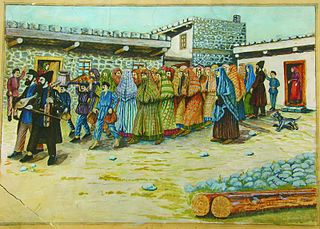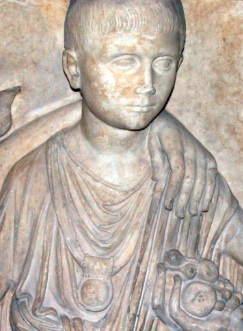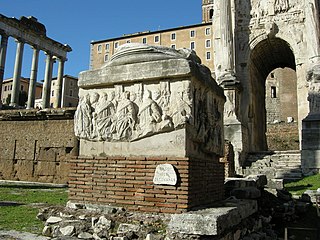
Lupercalia also known as Lupercal was a pastoral festival of Ancient Rome observed annually from February 13 through 15 to purify the city, promoting health and fertility. Lupercalia was also known as dies Februatus, after the purification instruments called februa, the basis for the month named Februarius.

Mystery religions, mystery cults, sacred mysteries or simply mysteries, were religious schools of the Greco-Roman world for which participation was reserved to initiates (mystai). The main characterization of this religion is the secrecy associated with the particulars of the initiation and the ritual practice, which may not be revealed to outsiders. The most famous mysteries of Greco-Roman antiquity were the Eleusinian Mysteries, which predated the Greek Dark Ages. The mystery schools flourished in Late Antiquity; Emperor Julian, of the mid 4th century, is believed by some scholars to have been associated with various mystery cults—most notably the mithraists. Due to the secret nature of the school, and because the mystery religions of Late Antiquity were persecuted by the Christian Roman Empire from the 4th century, the details of these religious practices are derived from descriptions, imagery and cross-cultural studies. Much information on the Mysteries comes from Marcus Terentius Varro.

Sacrifice is the offering of material possessions or the lives of animals or humans to a deity as an act of propitiation or worship. Evidence of ritual animal sacrifice has been seen at least since ancient Hebrews and Greeks, and possibly existed before that. Evidence of ritual human sacrifice can also be found back to at least pre-Columbian civilizations of Mesoamerica as well as in European civilizations. Varieties of ritual non-human sacrifices are practiced by numerous religions today.

In ancient Roman religion, the Manes or Di Manes are chthonic deities sometimes thought to represent souls of deceased loved ones. They were associated with the Lares, Lemures, Genii, and Di Penates as deities (di) that pertained to domestic, local, and personal cult. They belonged broadly to the category of di inferi, "those who dwell below," the undifferentiated collective of divine dead. The Manes were honored during the Parentalia and Feralia in February.

Animal sacrifice is the ritual killing and offering of one or more animals, usually as part of a religious ritual or to appease or maintain favour with a deity. Animal sacrifices were common throughout Europe and the Ancient Near East until the spread of Christianity in Late Antiquity, and continue in some cultures or religions today. Human sacrifice, where it existed, was always much rarer.

The Ashvamedha was a horse sacrifice ritual followed by the Śrauta tradition of Vedic religion. It was used by ancient Indian kings to prove their imperial sovereignty: a horse accompanied by the king's warriors would be released to wander for a year. In the territory traversed by the horse, any rival could dispute the king's authority by challenging the warriors accompanying it. After one year, if no enemy had managed to kill or capture the horse, the animal would be guided back to the king's capital. It would be then sacrificed, and the king would be declared as an undisputed sovereign.

A lictor was a Roman civil servant who was an attendant and bodyguard to a magistrate who held imperium. Roman records describe lictors as having existed since the Roman Kingdom, and may have originated with the Etruscans.

Ritual purification is a ritual prescribed by a religion through which a person is considered to be freed of uncleanliness, especially prior to the worship of a deity, and ritual purity is a state of ritual cleanliness. Ritual purification may also apply to objects and places. Ritual uncleanliness is not identical with ordinary physical impurity, such as dirt stains; nevertheless, body fluids are generally considered ritually unclean.

A flamen was a priest of the ancient Roman religion who was assigned to one of eighteen deities with official cults during the Roman Republic. The most important of these were the three flamines maiores, who served the important Roman gods Jupiter, Mars, and Quirinus. The remaining twelve were the flamines minores. Two of the minores served deities whose names are now unknown; among the others are deities about whom little is known other than the name. During the Imperial era, the cult of a deified emperor also had a flamen.
In ancient Roman religion, the Armilustrium was a festival in honor of Mars, the god of war, celebrated on October 19. On this day the weapons of the soldiers were ritually purified and stored for winter. The army would be assembled and reviewed in the Circus Maximus, garlanded with flowers. The trumpets (tubae) would be played as part of the purification rites. The Romans gathered with their arms and armour on the Aventine Hill, and held a procession with torches and sacrificial animals. The dancing priests of Mars known as the Salii may also have taken part in the ceremony.

In the Roman Empire of the second to fourth centuries, taurobolium referred to practices involving the sacrifice of a bull, which after mid-second century became connected with the worship of the Great Mother of the Gods; though not previously limited to her cult, after AD 159 all private taurobolia inscriptions mention the Magna Mater.

The suovetaurilia or suovitaurilia was one of the most sacred and traditional rites of Roman religion: the sacrifice of a pig, a sheep and a bull to the deity Mars to bless and purify land.

A bulla, an amulet worn like a locket, was given to male children in Ancient Rome nine days after birth. Rather similar objects are rare finds from Late Bronze Age Ireland.

In ancient Roman religion, the Liberalia was the festival of Liber Pater and his consort Libera. The Romans celebrated Liberalia with sacrifices, processions, ribald and gauche songs, and masks which were hung on trees.

In ancient Roman religion, the October Horse was an animal sacrifice to Mars carried out on October 15, coinciding with the end of the agricultural and military campaigning season. The rite took place during one of three horse-racing festivals held in honor of Mars, the others being the two Equirria on February 27 and March 14.

The Amburbium was an ancient Roman festival for purifying the city; that is, a lustration (lustratio urbis). It took the form of a procession, perhaps along the old Servian Wall, though the length of 10 kilometers would seem impractical to circumambulate. If it was a distinct festival held annually, the most likely month is February, but no date is recorded and the ritual may have been performed as a "crisis rite" when needed.

The supplicia canum was an annual sacrifice of ancient Roman religion in which live dogs were suspended from a furca ("fork") or cross (crux) and paraded. It appears on none of the extant Roman calendars, but a late source places it on August 3 (III Non. Aug.).
Childbirth in ancient Rome was dangerous for both the mother and the child. Mothers usually would rely on religious superstition to avoid death. Certain customs such as lying in bed after childbirth and using plants and herbs as relief were also practiced. Midwives assisted the mothers in birth. Once children were born they would not be given a name until 8 or 9 days after their birth. The number depended on if they were male or female. Once the days had past, the child would be gifted a name and a bulla during a ceremony. When a child reached the age of 1, they would gain legal privileges which could lead to citizenship. Children 7 and under were considered infants, and were under the care of women. From a age 8 until they reached adulthood children were expected to help with housework. The age of adulthood was 12 for girls, or 14 for boys. Children would often have a variety of toys to play with. If a child died they could be buried or cremated. Some would be commemorated in Roman religious tradition.

The Five-Columns monument is a dedicatory addition to the Rostra in the Roman Forum dating to the early fourth century CE. This monument was part of the Tetrarchy's expansion of the Forum and is connected to the tenth anniversary of the Caesares within the four-ruler system. It is also referred to as the Fünfsäulendenkmal as well as the four-column monument, depending on Jupiter's inclusion.
In ancient Rome the dies lustricus was a traditional naming ceremony in which an infant was purified and given a praenomen. This occurred on the eighth day for girls and the ninth day for boys, a difference Plutarch explains by noting that "it is a fact that the female grows up, and attains maturity and perfection before the male." Until the umbilical cord fell off, typically on the seventh day, the baby was regarded as "more like a plant than an animal," as Plutarch expresses it. The ceremony of the dies lustricus was thus postponed until the last tangible connection to the mother's body was dissolved and the child was seen "as no longer forming part of the mother, and in this way as possessing an independent existence which justified its receiving a name of its own and therefore a fate of its own." The day was celebrated with a family feast. The childhood goddess Nundina presided over the event, and the goddess Nona was supposed to determine a person's lifespan. Prior to the ceremony infants were not considered part of the household, even if their father had raised them up during a tollere liberum.















